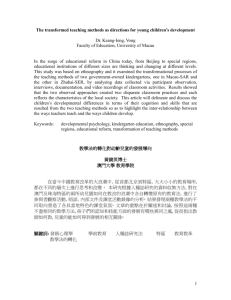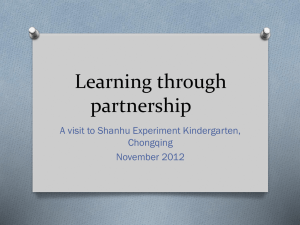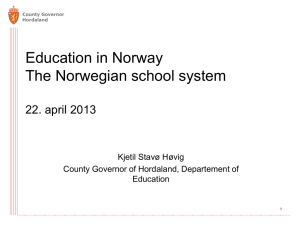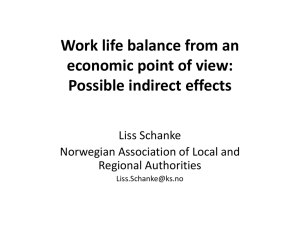China Pre-school Education (Kindergarten) Industry Research Report, 2016 Feb. 2016
advertisement
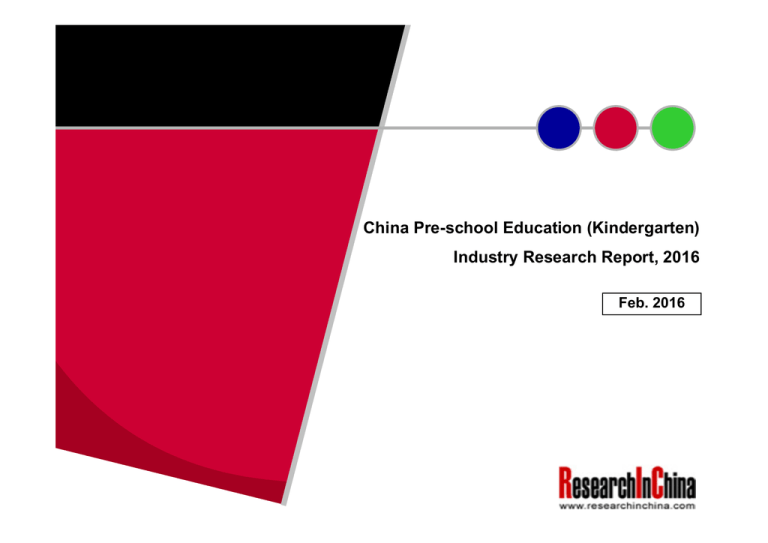
China Pre-school Education (Kindergarten) Industry Research Report, 2016 Feb. 2016 STUDY GOAL AND OBJECTIVES METHODOLOGY This report provides the industry executives with strategically significant Both primary and secondary research methodologies were used competitor information, analysis, insight and projection on the in preparing this study. Initially, a comprehensive and exhaustive competitive pattern and key companies in the industry, crucial to the search of the literature on this industry was conducted. These development and implementation of effective business, marketing and sources included related books and journals, trade literature, R&D programs. marketing literature, other product/promotional literature, annual reports, security analyst reports, and other publications. REPORT OBJECTIVES Subsequently, telephone interviews or email correspondence To T establish t bli h a comprehensive, h i ffactual, t l annually ll updated d t d and d costt was conducted with marketing executives etc. Other sources effective information base on market size, competition patterns, included related magazines, academics, and consulting market segments, goals and strategies of the leading players in the companies. market, reviews and forecasts. To assist potential market entrants in evaluating prospective acquisition and joint venture candidates. To complement the organizations’ internal competitor information INFORMATION SOURCES The primary information sources include Company Reports, and National Bureau of Statistics of China etc. gathering efforts with strategic analysis, data interpretation and insight. To suggest for concerned investors in line with the current development of this industry as well as the development tendency. tendency To help company to succeed in a competitive market, and Copyright 2012 ResearchInChina understand the size and growth rate of any opportunity. Room 502, Block 3, Tower C, Changyuan Tiandi Building, No. 18, Suzhou Street, Haidian District, Beijing, China 100080 Phone: +86 10 82600828 ● Fax: +86 10 82601570 ● www.researchinchina.com ● report@researchinchina.com Abstract Since 2010, China has introduced a number of policies such as the Outline of Medium and Long-term Programs for National Education Reform and Development (2010-2020), Preschool Education Three-Year Action Plan, etc. to strongly prompt the development of preschool education. As of 2014, China had invested RMB204.876 billion in preschool education, 8.37 times that in 2009, which basically eased the "kindergarten crunch" and other issues. Under the radical impetus of policies, China kindergarten industry advances rapidly and shows the following characteristics: 1, A substantial increase in the number of kindergartens, especially private kindergartens. In China, the number of kindergartens jumped from 116,000 in 2003 to approximately 219,000 at the end of 2015 with a CAGR of 5.4%; wherein, th number the b off private i t kindergartens ki d t swelled ll d ffrom 55 55,500 500 tto 143 143,500 500 att a CAGR off 8.2%. 8 2% 2, Significant regional differences due to varying economic levels. In 2015, Beijing, Shanghai, Guangzhou and other economically developed regions saw the gross enrollment rate of 3-year preschool education hit more than 95% while the central and western regions (such as Tibet, Yunnan, Guangxi and Ningxia) only about 60%. 3 Fewdominant enterprises, 3, enterprises low market concentration concentration. A kindergarten has limited range of influence, so the Chinese kindergarten market is scattered. Plus, nationwide brand kindergartens are rare, and the market CR5 is less than 2.0%. 4, The promising preschool education market attracts numerous listed companies. In 2015,, numerous listed companies p g got involved in kindergartens, g , for instance,, Jiangsu g Xiuqiang q g Glasswork Co.,, Ltd. acquired q Whole Person Education, Vtron Technologies Ltd. took over Hoing Education and Golden Cradle, Time Publishing and Media Co., Ltd. built its own kindergartens. 5, Preschool education + Internet becomes increasingly popular. Amid the development of Internet, brand kindergartens have enhanced competitiveness via the Internet. They mainly build websites to facilitate the interaction with parents, present online orientation courses, enroll students, etc. Copyright 2012ResearchInChina Room 502, Block 3, Tower C, Changyuan Tiandi Building, No. 18, Suzhou Street, Haidian District, Beijing, China 100080 Phone: +86 10 82600828 ● Fax: +86 10 82601570 ● www.researchinchina.com ● report@researchinchina.com Chi Preschool China P h l Ed Education ti (Ki (Kindergarten) d t ) Industry I d t Research R h Report, R t 2016 b by ResearchInChina R hI Chi focuses f on the th following: f ll i Development of China education industry (including number of various schools, enrollments, education funding and spending, private education, etc.); Development environment (including policies and society) and teaching models of kindergartens in China; Development of China kindergarten industry (containing number of kindergartens and enrollments by institution/province (municipality)/region, faculty and structure, competitive landscape, development trend, etc.); Development of private kindergartens (including relevant policies, number of kindergartens, enrollments, faculty and structure, operating modes, charges, competitive pattern, etc.); Development of kindergartens in Beijing, Shanghai, Tianjin, Chongqing, etc. (embracing overall conditions and development of private kindergartens); g ); 14 preschool education institutions (covering profile, educational philosophy, curriculum, regional distribution of kindergartens, charges, main kindergartens). Copyright 2012ResearchInChina Room 502, Block 3, Tower C, Changyuan Tiandi Building, No. 18, Suzhou Street, Haidian District, Beijing, China 100080 Phone: +86 10 82600828 ● Fax: +86 10 82601570 ● www.researchinchina.com ● report@researchinchina.com Table of contents 1. Development of China Education Industry 1.1 Development of Schools and Students 1 2 Education 1.2 Ed ti Fund F d Investment I t t 1.2.1 Educational Investment 1.2.2 Fixed-asset Investment 1.3 Education Spending 1.4 Private Education 2. Development Environment of China Kindergart en Industry 2.1 Concept 2 1 1 Preschool 2.1.1 P h l Education Ed ti 2.1.2 Kindergarten Education 2.2 Policies 2.2.1 Main Policies 2.2.2 Pre-school Educational Expenditure p 2.2.3 Special Central Funds 2.3 Social Environment 3. Teaching Models of Kindergarten 3 1 Overview 3.1 O i 3.2 John Dewey’s Activity Education 3.2.1 Teaching Idea 3.2.2 Teaching Goal 3.2.3 Operating p g Procedure 3.2.4 Role of Teachers and Students 3.2.5 Teaching Strategy 3.3 HighScope Curriculum 3.3.1 Teaching Idea 3.3.2 Teaching Goal 3.3.3 Teaching Content 3.3.4 Teaching Conditions 3.4 Montessori Education 3.5 3 5 Reggio gg Emilia Approach pp 3.6 Waldorf Education 3.7 Forest Kindergarten 4. Development of China Kindergarten Industry 4.1 Kindergartens Nationwide 4.1.1 Number of Kindergartens 4.1.2 New Entrants 4.1.3 Enrollments 4.2 Kindergartens g byy Institution 4.2.1 Number of Kindergartens 4.2.2 New Entrants 4.2.3 Enrollments 4.3 Kindergartens by Region 4.3.1 Number of Kindergartens 4.3.2 New Entrants 4.3.3 Enrollments 4.4 Kindergarten by Province/Municipality 4.4.1 Number of Kindergartens g 4.4.2 Enrollments 4.4.3 Average Enrollments of Each Kindergarten 4.4.4 Gross Enrollment Rate of 3Year Preschool Education 4 5 Faculty 4.5 F lt 4.5.1 Number of Faculty 4.5.2 Structure of Faculty 4.5.3 Student-Teacher Ratio and StudentFacultyy Ratio 4.6 Competitive Landscape 4.6.1 Kindergarten Competition 4.6.2 Regional Competition 4.7 Development Trend 5. Development of Private Kindergarten in China 5.1 Market Status and Policies 5.1.1 Market Status 5.1.2 Policies 5.2 Industry Operation 5.2.1 Number of Kindergartens 5.2.2 Number of Kindergarten Classes 5.2.3 New Entrants 5 2 4 Enrollments 5.2.4 E ll t 5.2.5 Faculty 5.2.6 Student-Teacher Ratio and StudentFaculty Ratio 5.3 Kindergartens g byy Province/Municipality p y 5.4 Operating Mode 5.5 Charge of Kindergarten Room 502, Block 3, Tower C, Changyuan Tiandi Building, No. 18, Suzhou Street, Haidian District, Beijing, China 100080 Phone: +86 10 82600828 ● Fax: +86 10 82601570 ● www.researchinchina.com ● report@researchinchina.com Table of contents 5.5.1 Overview 5.5.2 Charge of Public Kindergartens 5 5 3 Charge 5.5.3 Ch off Inclusive I l i Private P i t Kindergartens Ki d t 5.6 Competitive Landscape 6. Development of Kindergarten in Beijing 6.1 Policies 6.1.1 Beijing’s Plan for Medium and Longterm Education Reform and Development (20102020) 6.1.2 Beijing’s Plan for Education Reform and Develo pmentt during d i 12th Five-Year Fi Y Pl Period Plan P i d 6.2 Number of Kindergartens and Classes 6.2.1 Kindergartens6.2.2 Classes 6.3 Number of Students 6.3.1 New Entrants 6.3.2 Enrollments 6.4 Faculty, Student-Teacher Ratio and StudentFaculty Ratio 6.4.1 Number of Faculty 6 4 2 Student-Teacher 6.4.2 St d t T h Ratio R ti and d StudentSt d t Faculty Ratio 6.5 Kindergartens by District/County 6.6 Private Kindergarten 6.6.1 Number of Kindergartens g 6.6.2 Number of Students 6.6.3 Number of Faculty 6.7 Top 20 Kindergartens 7. Development of Kindergarten in Shanghai 7.1 Policies and Education Appropriations 7.1.1 Shanghai’s Plan for Medium and Longterm Education Reform and Development (20102020) 7.1.2 Shanghai’s Plan for Elementary Education Ref orm and Development during 12th FiveYear Plan Period 7.2 Number of Kindergartens 7.2.1 Kindergartens all over the City 7.2.2 Kindergartens by District/County 7.3 Number of Students 7.3.1 New Entrants 7.3.2 Enrollments 7.4 Faculty, Student-Teacher Ratio and StudentFaculty Ratio 7.4.1 Number of Faculty 7.4.2 Student-Teacher Ratio and StudentFaculty Ratio 7.5 Floor Space 7.5.1 Kindergartens all over the City 7.5.2 Kindergartens by District/County 7.6 Private Kindergarten 7.6.1 Private Kindergarten 7.6.2 Number of Students 7.6.3 Number of Faculty 7.7 Number of Faculty 8. Development of Kindergarten in Tianjin 8.1 Relevant Policies 8.2 Number of Kindergartens 8.3 Number of Students 8.3.1 New Entrants 8.3.2 Enrollments 8.4 Faculty, Student-Teacher Ratio and StudentFaculty Ratio 8.4.1 Number of Faculty 8.4.2 Student-Teacher Ratio and StudentFaculty Ratio 8.5 Private Kindergartens 8.5.1 8 5 Number u be o of Kindergartens de ga te s 8.5.2 County/District Kindergartens 8.6 Top12 Kindergartens 9. Development of Kindergarten in Chongqing 9.1 Relevant Policies 9.2 Number of Kindergartens 9.3 Number of Students 9.3.1 New Entrants 9.3.2 9 3 Enrollments o e ts 9.4 Faculty, Student-Teacher Ratio and StudentFaculty Ratio Room 502, Block 3, Tower C, Changyuan Tiandi Building, No. 18, Suzhou Street, Haidian District, Beijing, China 100080 Phone: +86 10 82600828 ● Fax: +86 10 82601570 ● www.researchinchina.com ● report@researchinchina.com Table of contents 9.4.1 Number of Faculty 9.4.2 Student-Teacher Ratio and Student-Faculty Ratio 9.5 Private Kindergartens 9.5.1 Number of Kindergartens 9.5.2 Number of Students 9.6 Top15 Kindergartens 10. Major Preschool Education Institutions in China 10.1 Etonkids Educational Group 10.1.1 Profile 10.1.2 Methodology and Academic Programs 10.1.3 Regional Distribution of Kindergartens 10.1.4 Teacher Allocation 10.1.5 Charge (Taking Beijing as an Example) 10.2 Golden Kids International School 10.2.1 0 Profile o e 10.2.2 Educational Philosophy 10.2.3 Main Kindergartens 10.2.4 Charge 10.3 R.Y.B. Education Institution 10.3.1 Profile 10.3.2 Educational Philosophy and Curriculum 10.3.3 Profit Model 10.3.4 Regional Distribution of Kindergartens 10.4 0 Kid d Cast Castle e Educational ducat o a Institute st tute 10.4.1 Profile 10.4.2 Educational Concept and Curriculum 10.4.3 Business Model 10.5 Golden Cradle Potential Education Institution 10.5.1 Profile 10.5.2 Development Course 10.5.3 Regional Distribution of Kindergartens 10.5.4 Educational Programs and Curriculum 10.6 Tomorrow Kindergarten Group 10.6.1 Profile 10.6.2 Educational Idea and Projects 10.6.3 Regional Distribution of Kindergartens 10.6.4 Tuition 10.7 HOING Education 10.7.1 Profile 10.7.2 Number of Kindergartens 10.7.3 Operation 10.8 08O Oriental e ta Ca Cambridge b dge Education ducat o G Group oup 10.8.1 Profile 10.8.2 Regional Distribution of Kindergartens 10.8.3 Education Characteristics 10.9 Little Harvard Education Group 10.9.1 Profile 10.9.2 Cooperative Companies 10.9.3 Main Kindergartens 10.10 New Oriental Stars Education & Consulting Co., Ltd. 10.10.1 0 0 Profile o e 10.10.2 Operating Model 10.11 Others Room 502, Block 3, Tower C, Changyuan Tiandi Building, No. 18, Suzhou Street, Haidian District, Beijing, China 100080 Phone: +86 10 82600828 ● Fax: +86 10 82601570 ● www.researchinchina.com ● report@researchinchina.com Selected Charts • • • • • • • • • • • • • • • • • • • • • • • • • Number of Schools in China by Type, 2008-2016 Number of New Entrants in China by School Type, Type 2008-2016 Enrollments of Schools in China by Type, 2008-2016 Total Investment and YoY Growth of Educational Funds in China, 2003-2020 Fiscal Educational Funds and YoY Growth in China, 2003-2020 Spending p g on Education and % of Total Public Spending p g in China by y Province/Municipality, p y 2014 Urban Fixed-asset Investment and YoY Growth in China’s Education Industry, 2003-2020 Per Capita Annual Consumer Spending of Urban Residents on Education, 2003-2020 Number of Private Schools and Training Institutions in China, 2008-2016 Number of Students on Campus of Private Schools in China, 2008-2016 Main Modes, Core Elements, and Representative Enterprises of Preschool Education Preschool Education Policies in China, 2010-2016 Pre-school Educational Expenditure in China, 2009-2016E National Financial Educational Expenditures on Kindergartens in China, 2009-2016E P Proportion ti off Financial Fi i l Pre-school P h l Educational Ed ti l Expenditures E dit i China in Chi and d Abroad Ab d Ratio of Financial Expenditures on Kindergartens to National Financial Spending on Education in China, 2003-2016E Special Central Funds for Development of Pre-school Education, 2011-2015 Births and Birthrate in China, 2011-2020E Per Capita Disposable Income of Urban and Rural Residents in China, China 2013 2013-2020E 2020E Structure of Teaching Model Number and YoY Growth of Kindergartens in China, 2003-2016E Number of Classes and YoY Growth of Kindergartens in China, 2003-2016E Average Number of Classes of Each Kindergarten in China, 2003-2016E Number of New Entrants and YoY Growth of Kindergartens in China, 2003-2016E Number of New Entrants of Kindergartens in China by Age, 2005-2016E Room 502, Block 3, Tower C, Changyuan Tiandi Building, No. 18, Suzhou Street, Haidian District, Beijing, China 100080 Phone: +86 10 82600828 ● Fax: +86 10 82601570 ● www.researchinchina.com ● report@researchinchina.com Selected Charts • • • • • • • • • • • • • • • • • • • • • • • • • Enrollments and YoY Growth of Kindergartens in China, 2003-2016E Enrollments of Kindergartens in China by Age, Age 2005-2016E Average Enrollments of Each Kindergarten in China, 2003-2016E Gross Enrollment Rate of 3-Year Preschool Education in China, 2003-2016E Number of Kindergartens in China by Institution, 2005-2016E Number of Classes of Kindergartens g in China by y Institution, 2005-2016E Average Number of Classes of Each Kindergarten in China by Institution, 2005-2016E Number of New Entrants of Kindergartens in China by Institution, 2005-2016E Enrollments of Kindergartens in China by Institution, 2005-2016E Average Enrollments of Each Kindergarten in China by Institution, 2005-2016E Number of Kindergartens in China by Region, 2003-2016E Number of Classes of Kindergartens in China by Region, 2003-2016E Average Number of Classes of Each Kindergarten in China by Region, 2003-2016E Number of New Entrants of Kindergartens in China by Region, 2003-2016E E ll Enrollments t off Kindergartens Ki d t i China in Chi by b Region, R i 2003 2016E 2003-2016E Average Enrollments of Each Kindergarten in China by Region, 2003-2016E Number of Kindergartens in China by Province/Municipality as of the end of 2014 Enrollments of Kindergartens in China by Province/Municipality, 2014 Average Enrollments of Each Kindergarten in China by Province/Municipality, Province/Municipality 2014 Gross Enrollment Rate of 3-Year Preschool Education in China by Province/Municipality, 2010/2015 Faculty Number and YoY Growth of Kindergartens in China, 2003-2016E Average Faculty Number of Each Kindergarten in China, 2003-2016 Faculty Structure of Kindergartens in China by Type, 2003-2016E Average Faculty Structure of Each Kindergarten in China by Type, 2003-2016E Student-Teacher Ratio and Student-Faculty Ratio of Kindergartens in China, 2003-2016E Room 502, Block 3, Tower C, Changyuan Tiandi Building, No. 18, Suzhou Street, Haidian District, Beijing, China 100080 Phone: +86 10 82600828 ● Fax: +86 10 82601570 ● www.researchinchina.com ● report@researchinchina.com Selected Charts • • • • • • • • • • • • • • • • • • • • • • • • • China’s Top 50 Kindergartens and Their Nature Regional Distribution of Top 500 Kindergartens in China by Province/Municipality Classification of Private Kindergarten Classification of Private Kindergarten Number and YoY Growth of Private Kindergartens in China, 2003-2016 Number of Private Kindergartens g in China by y Region, g 2003-2016 Proportion of Private Kindergartens in China's Total by Region, 2003-2016 Number of Classes and YoY Growth of Private Kindergartens in China, 2003-2016 Number of Classes of Private Kindergartens in China by Region, 2003-2016 Proportion of Classes of Private Kindergartens in China’s Total by Region, 2003-2016 Average Number of Classes of Each Private Kindergarten in China by Region, 2003-2016 Number of New Entrants of and YoY Growth of Private Kindergartens in China, 2005-2016 Number of New Entrants of Private Kindergartens in China by Region, 2005-2016 64 Proportion of New Entrants from Private Kindergartens in China’s Total Kindergartens by Region, 2005-2016 E ll Enrollments t and d YoY Y Y Growth G th off Private P i t Kindergartens Ki d t i China, in Chi 2005 2016 2005-2016 Enrollments of Private Kindergartens in China by Region, 2005-2016 Average Enrollments of Each Private Kindergarten in China, 2005-2016 Faculty Number and YoY Growth of Private Kindergartens in China, 2003-2016 Faculty Structure of Private Kindergartens in China by Type, Type 2003 2003-2016 2016 Faculty Structure of Each Private Kindergarten in China by Type, 2003-2016 Faculty Number of Private Kindergartens in China by Region, 2003-2016 Average Faculty Number of Each Private Kindergarten in China by Region, 2003-2016 Student-Teacher Ratio and Student-Faculty Ratio of Private Kindergartens in China, 2003-2016 Number of Private Kindergartens in China by Province/Municipality as of the End of 2014 Proportion of Private Kindergartens in Total Kindergartens in All Chinese Provinces/Municipalities, 2010/2014 Room 502, Block 3, Tower C, Changyuan Tiandi Building, No. 18, Suzhou Street, Haidian District, Beijing, China 100080 Phone: +86 10 82600828 ● Fax: +86 10 82601570 ● www.researchinchina.com ● report@researchinchina.com Selected Charts • • • • • • • • • • • • • • • • • • • • • • • • • Operating Mode of Private Kindergartens Charges of Public Kindergartens in Some Chinese Cities Charges of Inclusive Private Kindergartens in Some Chinese Cities Kindergarten Layout of Private Education Institutions (Top 5) in China SWOT Analysis of Private Kindergartens in China Number and YoY Growth of Kindergartens g in Beijing, j g 2003-2016 Number of Kindergartens in Beijing by Region, 2013-2016 Number of Classes and YoY Growth of Kindergartens in Beijing, 2003-2016 Number of Classes of Kindergartens in Beijing by Region, 2013-2016 Average Class Number of Each Kindergarten in Beijing, 2003-2016 Number of New Entrants and YoY Growth of Kindergartens in Beijing, 2003-2016 Enrollments and YoY Growth of Kindergartens in Beijing, 2003-2016 Enrollments of Kindergartens in Beijing by Region, 2013-2016 Enrollments of Each Kindergarten in Beijing, 2003-2016 E ll Enrollments t off Each E h Class Cl off Kindergartens Ki d t i Beijing, in B iji 2003 2016 2003-2016 Faculty Number and YoY Growth of Kindergartens in Beijing, 2003-2016 Number and YoY Growth of Full-time Teachers in Kindergartens in Beijing, 2003-2016 Faculty Structure of Kindergartens in Beijing by Region, 2013-2016 Faculty Structure of Kindergartens in Beijing by Type, Type 2014 Student-Teacher Ratio and Student-Faculty Ratio of Kindergartens in Beijing, 2003-2016 Number of Kindergartens and Full-time Teachers and Enrollments in Beijing by District/County, 2012-2014 Number and YoY Growth of Private Kindergartens in Beijing, 2005-2016 Proportion of Private Kindergartens in Beijing’s Total, 2005-2016 Number of New Entrants and YoY Growth of Private Kindergartens in Beijing, 2009-2016 Enrollments and YoY Growth of Private Kindergartens in Beijing, 2009-2016 Room 502, Block 3, Tower C, Changyuan Tiandi Building, No. 18, Suzhou Street, Haidian District, Beijing, China 100080 Phone: +86 10 82600828 ● Fax: +86 10 82601570 ● www.researchinchina.com ● report@researchinchina.com Selected Charts • • • • • • • • • • • • • • • • • • • • • • • • • Proportion of New Entrants and Enrollments from Private Kindergartens in Beijing’s Total, 2009-2016 Average Enrollments of Each Private Kindergarten in Beijing, Beijing 2009-2016 Faculty Number and YoY Growth of Private Kindergartens in Beijing, 2009-2016 Number and YoY Growth of Full-time Teachers of Private Kindergartens in Beijing, 2009-2016 Student-Teacher Ratio and Student-Faculty Ratio of Private Kindergartens in Beijing, 2009-2016 Beijing’s j g Top p 20 Kindergartens g and Their Nature Number and YoY Growth of Kindergartens in Shanghai, 2003-2016 Number of Kindergartens in Shanghai by District/County, 2010-2014 Number of New Entrants and YoY Growth of Kindergartens in Shanghai, 2003-2016 Number of New Entrants of Kindergartens in Shanghai by District/County, 2010-2014 Enrollments and YoY Growth of Kindergartens in Shanghai, 2003-2016 Enrollments of Kindergartens in Shanghai by District/County, 2010-2014 Average Enrollments of Each Kindergarten in Shanghai, 2003-2016 Faculty Number and YoY Growth of Kindergartens in Shanghai, 2003-2016 N b off Full-time Number F ll ti T Teachers h and d YoY Y Y Growth G th off Kindergartens Ki d t i Shanghai, in Sh h i 2003-2016 2003 2016 Faculty Number of Kindergartens in Shanghai by District/County, 2010-2014 Number of Full-time Teachers of Kindergartens in Shanghai by District/County, 2010-2014 Student-Teacher Ratio and Student-Faculty Ratio of Kindergartens in Shanghai, 2003-2016 Student-Teacher Student Teacher Ratio and Student Student-Faculty Faculty Ratio of Kindergartens in Shanghai by District/County, District/County 2010 2010-2014 2014 Floor Area of All Kindergartens and Each Kindergarten in Shanghai, 2003-2016 Floor Area of All Kindergartens and Each Kindergarten in Shanghai by District/County, 2010-2014 Number and YoY Growth of Private Kindergartens in Shanghai, 2003-2016 Proportion of Private Kindergartens in Shanghai’s Total, 2003-2016 Number of New Entrants and YoY Growth of Private Kindergartens in Shanghai, 2003-2016 Enrollments and YoY Growth of Private Kindergartens in Shanghai, 2003-2016 Room 502, Block 3, Tower C, Changyuan Tiandi Building, No. 18, Suzhou Street, Haidian District, Beijing, China 100080 Phone: +86 10 82600828 ● Fax: +86 10 82601570 ● www.researchinchina.com ● report@researchinchina.com Selected Charts • • • • • • • • • • • • • • • • • • • • • • • • • Proportion of New Entrants and Enrollments from Private Kindergartens in Shanghai’s Total, 2003-2016 Average Enrollments of Each Private Kindergarten in Shanghai, Shanghai 2003-2016 Number of Full-time Teachers and YoY Growth of Private Kindergartens in Shanghai, 2003-2016 Student-Teacher Ratio of Private Kindergartens in Shanghai, 2003-2016 Shanghai’s Top 20 Kindergartens and Their Nature Major j Policies on Preschool Education in Tianjin, j 2010-2016 Number and YoY Growth of Kindergartens in Tianjin, 2006-2016 Number of New Entrants and YoY Growth of Kindergartens in Tianjin, 2006-2016 Enrollments and YoY Growth of Kindergartens in Tianjin, 2006-2016 Average Enrollments of Each Kindergarten in Tianjin, 2006-2016 Faculty Number and YoY Growth of Kindergartens in Tianjin, 2006-2016 Number of Full-time Teachers and YoY Growth of Kindergartens in Tianjin, 2006-2016 Student-Teacher Ratio and Student-Faculty Ratio of Kindergartens in Tianjin, 2006-2016 Number and YoY Growth of Private Kindergartens in Tianjin, 2006-2016 P Proportion ti off Private P i t Kindergartens Ki d t i Tianjin’s in Ti ji ’ Total, T t l 2006-2016 2006 2016 Private Kindergartens with Enrollment Qualification in Tianjin by District/County, 2014 Ranking of Tianjin’s Top 12 Kindergartens and Their Nature Major Policies on Preschool Education in Chongqing, 2010-2016 Number and YoY Growth of Kindergartens in Chongqing, Chongqing 2003 2003-2016 2016 Number of New Entrants and YoY Growth of Kindergartens in Chongqing, 2005-2016 Enrollments and YoY Growth of Kindergartens in Chongqing, 2005-2016 Average Enrollments of Each Kindergarten in Chongqing, 2005-2016 Enrollment Rate of 3-Year Preschool Education in Chongqing, 2005-2020E Faculty Number and YoY Growth of Kindergartens in Chongqing, 2005-2016 Number of Full-time Teachers and YoY Growth of Kindergartens in Chongqing, 2005-2016 Room 502, Block 3, Tower C, Changyuan Tiandi Building, No. 18, Suzhou Street, Haidian District, Beijing, China 100080 Phone: +86 10 82600828 ● Fax: +86 10 82601570 ● www.researchinchina.com ● report@researchinchina.com Selected Charts • • • • • • • • • • • • • • • • • • • • • • • • • Student-Teacher Ratio and Student-Faculty Ratio of Kindergartens in Chongqing, 2005-2016 Number and YoY Growth of Private Kindergartens in Chongqing, Chongqing 2005-2016 2005 2016 Proportion of Private Kindergartens in Chongqing’s Total, 2005-2016 Enrollments and YoY Growth of Private Kindergartens in Chongqing, 2005-2016 Proportion of Enrollments for Private Kindergartens in Chongqing's Total, 2005-2016 Average g Enrollments of Each Private Kindergarten g in Chongqing, gq g, 2005-2016 Chongqing’s Top 15 Kindergartens and Their Nature, 2013 Number of Etonkids Kindergartens by City as of 2015 Teacher's Disposition of Etonkids Curriculum Examples of Golden Kids Kindergarten Development Milestones of R.Y.B. Education Institution, 1998-2015 Courses of R.Y.B Kindergarten and Early Years Center Number of R.Y.B Kindergartens by Province/Municipality as of 2015 Study Plan of Kid Castle N b off Kid Castle Number C tl Kindergartens Ki d t b City by Cit as off 2015 Milestones of Golden Cradle Directly-managed Kindergartens under Beijing Golden Cradle Potential Education Institution Number of Franchised Kindergartens of Golden Cradle by Province/Municipality as of 2015 0-16-year-old Growth Management High-Quality Education Ecosystem of Golden Cradle Profile of Major Training Course of Golden Cradle Kindergartens directly under Tomorrow Kindergarten by the end of 2015 Number of Franchised Kindergartens of Beijing Tomorrow Kindergarten Group by Province/Municipality as of 2015 Tuition Standard of Tomorrow Kindergarten g Group p ((Take Beijing j g Yiyou y Tayuan y Campus p as Example) p ) Number of Kindergartens of HOING Education, 2008-2016E Revenue Structure of HOING Education, 2014 Room 502, Block 3, Tower C, Changyuan Tiandi Building, No. 18, Suzhou Street, Haidian District, Beijing, China 100080 Phone: +86 10 82600828 ● Fax: +86 10 82601570 ● www.researchinchina.com ● report@researchinchina.com Selected Charts • • • • • Net Income of HOING Education, 2013-2017E Number of Kindergartens of Oriental Cambridge by Province/Municipality as of Nov. Nov 2015 Kindergartens of Little Harvard Kindergarten Coverage of Boyuan Education Profitability of F-Dadi, 2010-2016E Room 502, Block 3, Tower C, Changyuan Tiandi Building, No. 18, Suzhou Street, Haidian District, Beijing, China 100080 Phone: +86 10 82600828 ● Fax: +86 10 82601570 ● www.researchinchina.com ● report@researchinchina.com How to Buy You can place your order in the following alternative ways: Choose type of format 1 O d online 1.Order li at www.researchinchina.com hi hi PDF (Single user license) …………..2,400 USD 2.Fax order sheet to us at fax number:+86 10 82601570 Hard copy 3. Email your order to: report@researchinchina.com PDF (Enterprisewide license)…....... 3,700 USD ………………….……. 2,600 USD 4 Phone us at +86 10 82600828/ 82601561 4. Party A: Name: Address: Contact Person: E-mail: Party B: Name: Address: ※ Reports will be dispatched immediately once full p payment y has been received. Tel Fax Payment may be made by wire transfer or Beijing Waterwood Technologies Co., Ltd (ResearchInChina) Room 502, Block 3, Tower C, Changyuan Tiandi Building, No. 18, Suzhou Street, Street Haidian District, District Beijing, Beijing China 100080 Liao Yan Phone: 86-10-82600828 credit card via PayPal. Contact Person: E-mail: report@researchinchina.com Fax: 86-10-82601570 Bank details: Beneficial Name: Beijing Waterwood Technologies Co., Ltd Bank Name: Bank of Communications, Beijing Branch Bank Address: NO.1 NO 1 jinxiyuan shijicheng,Landianchang,Haidian shijicheng Landianchang Haidian District,Beijing Bank Account No #: 110060668012015061217 Routing No # : 332906 Bank SWIFT Code: COMMCNSHBJG Title Format Cost Total Room 502, Block 3, Tower C, Changyuan Tiandi Building, No. 18, Suzhou Street, Haidian District, Beijing, China 100080 Phone: +86 10 82600828 ● Fax: +86 10 82601570 ● www.researchinchina.com ● report@researchinchina.com RICDB service About ResearchInChina ResearchInChina (www.researchinchina.com) is a leading independent provider of China business intelligence. Our research is designed to meet the diverse planning and information needs of businesses, institutions, and professional investors worldwide. Our services are used in a variety of ways, including strategic planning, product and sales forecasting, risk and sensitivity management, and as investment research. Our Major Activities M lti Multi-users market k t reports t Database-RICDB Custom Research Company Search For any problems, please contact our service team at: Room 502, Block 3, Tower C, Changyuan Tiandi Building, No. 18, Suzhou Street, Haidian District, Beijing, China 100080 Phone: +86 10 82600828 ● Fax: +86 10 82601570 ● www.researchinchina.com ● report@researchinchina.com
